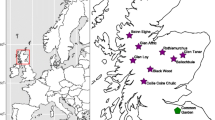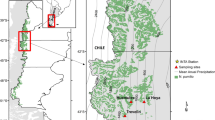Abstract
Hydraulic failure can cause massive die-back of forest trees during drought. With extreme climatic events set to become more frequent and severe due to climatic change, it is essential to study resistance to water stress-induced cavitation. We investigated the genetic differentiation for cavitation resistance among Pinus hartwegii populations, the pine species growing at the treeline in México. Open-pollinated seeds were collected from seven natural populations along an altitudinal gradient (3,150–3,650 masl) from Pico de Tancítaro, Michoacán, western México. Seedlings were raised in a nursery and then established in a randomized complete block design in a common garden experiment. Resistance to cavitation (P 50, xylem pressure inducing 50 % loss of hydraulic conductance and S, slope of the vulnerability curve) and specific hydraulic conductivity (k s), were evaluated on branches of 5-year-old seedlings using the Cavitron technique. Mean P 50 was −3.42 ± 0.05 MPa, indicating that Pinus hartwegii is one of the more vulnerable pine species to cavitation. No significant genetic differentiation was detected between populations for cavitation resistance traits (P 50 and S), but a significant altitudinal cline was found for S. In contrast, k s exhibited a significant differentiation among populations and a significant decline with increasing altitude. The lack of genetic differentiation among P. hartwegii populations for cavitation resistance is likely to represent a limitation for adapting to the warmer and drier climates that are expected to occur in México under climatic change. Finally, a worldwide comparison within the Pinus genus showed that pines growing at the treeline were on average more vulnerable to cavitation than those from lowland. This might reflect an adaptation to dry environmental conditions at low elevation.


Similar content being viewed by others
References
Allen CD, Macalady AK, Chenchouni H, Bachelet D, McDowell N, Vennetier M, Kizberger T, Rigling A, Breshears DD, Hogg EH, Gonzalez P, Fensham R, Zhang Z, Castro J, Demidova N, Lim JH, Allard G, Running SW, Semerci A, Cobb N (2010) A global overview of drought and heat-induced tree mortality reveals emerging climate change risks for forests. For Ecol Manage 259:660–684
Bower AD, Aitken SN (2008) Ecological genetics and seed transfer guidelines for Pinus albicaulis (Pinaceae). Am J Bot 95(1):66–76
Bower AD, Aitken SN (2011) Changes in genetic diversity of whitebark pine (Pinus albicaulis Engelm.) associated with inbreeding and white pine blister rust infection. Silvae Genet 60(3–4):113–123
Breshears DD, Cobb NS, Rich PM, Price KP, Allen CD, Balice RG, Romme WH, Kastens JH, Floyd ML, Belnap J, Anderson JJ, Myers OB, Meyer CW (2005) Regional vegetation die-off in response to global-change-type drought. Proc Natl Acad Sci 102:15144–15148
Bresson CC, Kowalski AS, Kremer A, Delzon S (2009) Evidence of altitudinal increase in photosynthetic capacity: gas exchange measurements at ambient and constant CO2 partial pressures. Ann For Sci 66:505
Bresson CC, Vitasse Y, Kremer A, Delzon S (2011) To what extent is altitudinal variation of functional traits driven by genetic adaptation in European oak and beech? Tree Physiol 31:1164–1174
Brodribb TJ, Cochard H (2009) Hydraulic failure defines the recovery and point of death in water-stressed conifers. Plant Physiol 149:575–584
Brodribb TJ, Bowman DJMS, Nichols S, Delzon S, Burlett R (2010) Xylem function and growth rate interact to determine recovery rates after exposure to extreme water deficit. New Phytol 188:533–542
Choat B, Jansen S, Brodribb TJ, Cochard H, Delzon S, Bhaskar R, Bucci SJ, Feild TS, Gleason SM, Hacke UG, Jacobsen AL, Lens F, Maherali H, Martínez-Vilalta J, Mayr S, Mencuccini M, Mitchell PJ, Nardini A, Pittermann J, Pratt RB, Sperry JS, Westoby M, Wright IJ, Zanne AE (2012) Global convergence in the vulnerability of forests to drought. Nature 491:752–756
Christensen KI (1987) Taxonomic revision of the Pinus mugo complex and P. × rhaetica (P. mugo × sylvestris) (Pinaceae). Nord J Bot 7:383–408
Cochard H (2002) A technique for measuring xylem hydraulic conductance under high negative pressures. Plant Cell Environ 25:815–819
Cochard H, Damour G, Bodet C, Tharwat I, Poirier M, Ameglio T (2005) Evaluation of a new centrifuge technique for rapid generation of xylem vulnerability curves. Physiol Plant 124:410–418
Corcuera L, Cochard H, Gil-Pelegrin E, Notivol E (2011) Phenotypic plasticity in mesic populations of Pinus pinaster improves resistance to xylem embolism (P50) under severe drought. Trees-Struct Funct 25:1033–1042
Critchfield WB, Little EL Jr (1966) Geographic distribution of the pines of the world. Miscellaneous Publication, Washington
Dalla-Salda G, Martinez-Meier A, Cochard H, Rozenberg P (2011) Genetic variation of xylem hydraulic properties shows that wood density is involved in adaptation to drought in Douglas-fir (Pseudotsuga menziesii (Mirb.)). Ann For Sci 68(4):747–757
Davis SD, Sperry JS, Hacke UG (1999) The relationship between xylem conduit diameter and cavitation caused by freezing. Am J Bot 86(10):1367–1372
Delzon S, Douthe C, Sala A, Cochard H (2010) Mechanism of water-stress induced cavitation in conifers: bordered pit structure and function support the hypothesis of seal capillary-seeding. Plant Cell Environ 33(12):2101–2111
Ennajeh M, Tounekti T, Vadel AM, Khemira H, Cochard H (2008) Water relations and drought-induced embolism in olive (Olea europaea) varieties ‘Meski’ and ‘Chemlali’ during severe drought. Tree Physiol 28:971–976
Gomez-Mendoza L, Arriaga L (2007) Modeling the effect of climate change on the distribution of oak and pine species of México. Conserv Biol 21(6):1545–1555
Hacke UG, Sperry JS, Pittermann J (2004) Analysis of circular bordered pit function II. Gymnosperm tracheids with torus-margo pit membranes. Am J Bot 91(3):386–400
Jansen S, Lamy JB, Burlett R, Cochard H, Gasson P, Delzon S (2012) Plasmodesmatal pores in the torus of bordered pit membranes affect cavitation resistance of conifer xylem. Plant Cell Environ 35(6):1109–1120
Kavanagh KL, Bond BJ, Aitken SN, Gartner BL, Knowe S (1999) Shoot and root vulnerability to xylem cavitation in four populations of Douglas-fir seedlings. Tree Physiol 19:31–37
Kolb KJ, Sperry JS (1999) Differences in drought adaptation between subspecies of sagebrush Artemisia tridentata. Ecology 80(7):2373–2384
Lamy J-B, Bouffier L, Burlett R, Plomion C, Cochard H, Delzon S (2011) Uniform selection as a primary force reducing population genetic differentiation of cavitation resistance across a species range. PLoS ONE 6(8):e23476. doi:10.1371/journal.pone.0023476
Lauer W (1978) Timberline studies in central Mexico. Arct Alp Res 10:383–396
Loya-Rebollar E, Sáenz-Romero C, Lindig-Cisneros RA, Lobit P, Villegas-Moreno JA, Sánchez-Vargas NM (2013) Clinal variation in Pinus hartwegii populations and its application for adaptation to climatic change. Silvae Genet (in press)
Maherali H, Pockman WT, Jackson RB (2004) Adaptive variation in the vulnerability of woody plants to xylem cavitation. Ecology 85:2184–2199
Martínez-Vilalta J, Cochard H, Mencuccini M, Sterck F, Herrero A, Korhonen JFJ, Llorens P, Nikinmaa E, Nolè A, Poyatos R, Ripullone F, Sass-Klaassen U, Zweifel R (2009) Hydraulic adjustment of Scots pine across Europe. New Phytol 184:353–364
Matos JA, Schaal BA (2000) Chloroplast evolution in the Pinus montezumae complex: a coalescent approach to hybridization. Evolution 54:1218–1233
Mátyás C (2010) Forecasts needed for retreating forests. Nature 464:1271
Mátyás C, Berki I, Czúcz Gálos B, Móricz N, Rasztovits E (2010) Future of beech in Southern Europe from the perspective of evolutionary ecology. Acta Silv. Lign Hung 6:91–110
Matzner SL, Rice KJ, Richards JH (2001) Intra-specific variation in xylem cavitation in interior live oak (Quercus wislizenii A. DC.). J Exp Bot 52:783–789
Mencuccini M, Comstock J (1997) Vulnerability to cavitation in populations of two desert species, Hymenoclea salsola and Ambrosia dumosa, from different climatic regions. J Exp Bot 48(311):1323–1334
Pammenter NW, Van der Willigen C (1998) A mathematical and statistical analysis of the curves illustrating vulnerability of xylem to cavitation. Tree Physiol 18:589–593
Peguero-Pina JJ, Sancho-Knapik D, Cochard H, Barredo G, Villarroya D, Gil-Pelegrín E (2011) Hydraulic traits are associated with the distribution range of two closely related Mediterranean firs, Abies alba Mill and Abies pinsapo Boiss. Tree Physiol 31(10):1067–1075
Peñuelas J, Oyaga R, Boada M, Jump AS (2007) Migration, invasion and decline: changes in recruitment and forest structure in a warming-linked shift of European beech forest in Catalonia (NE Spain). Ecography 30:830–838
Perry JP (1991) The pine of Mexico and Central America. Timber Press, Portland
Pittermann J, Sperry J (2003) Tracheid diameter is the key trait determining the extent of freezing induced embolism in conifers. Tree Physiol 23:907–914
Pittermann J, Sperry JS (2006) Analysis of freeze–thaw embolism in conifers; the interaction between cavitation pressure and tracheid size. Plant Physiol 140:374–382
Pittermann J, Sperry JS, Hacke UG, Wheeler JK, Sikkema EH (2006a) Inter-tracheid pitting and the hydraulic efficiency of conifer wood: the role of tracheid allometry and cavitation protection. Am J Bot 93(9):1265–1273
Pittermann J, Sperry JS, Wheeler JK, Hacke UG, Sikkema EH (2006b) Mechanical reinforcement of tracheids compromises the hydraulic efficiency of conifer xylem. Plant Cell Environ 29:1618–1628
Pittermann J, Choat B, Jansen S, Stuart SA, Lynn L, Dawson TE (2010) The relationships between xylem safety and hydraulic efficiency in the Cupressaceae: the evolution of pit membrane form and function. Plant Physiol 153:1919–1931
Premoli AC, Brewer C (2007) Environmental v. genetically driven variation in ecophysiological traits of Nothofagus pumilio from contrasting elevations. Austr J Bot 55:585–591
Rehfeldt GE, Jaquish BC (2010) Ecological impacts and management strategies for western larch in the face of climate-change. Mitig Adapt Strat Glob Change 15:283–306
Rehfeldt GE, Ferguson DE, Crookston NL (2009) Aspen, climate, and sudden decline in western USA. For Ecol Manag 258:2353–2364
Rehfeldt GE, Crookston NL, Sáenz-Romero C, Campbell E (2012) North American vegetation model for land use planning in a changing climate: a solution to large classification problems. Ecol Appl 22:119–141
Ricker M, Gutiérrez-García G, Daly DC (2007) Modeling long-term tree growth curves in response to warming climate: test cases from a subtropical mountain forest and a tropical rainforest in México. Can J Res 37:977–989
Sáenz-Romero C, Guzmán-Reyna R, Rehfeldt GE (2006) Altitudinal genetic variation among Pinus oocarpa populations in Michoacán, México; implications for seed zoning, conservation of forest genetic resources, tree breeding and global warming. For Ecol Manag 229:340–350
Sáenz-Romero C, Rehfeldt GE, Crookston NL, Pierre D, St-Amant R, Bealieau J, Richardson B (2010) Spline models of contemporary, 2030, 2060, and 2090 climates for Mexico and their use in understanding climate-change impacts on the vegetation. Clim Chang 102:595–623
SAS Institute Inc. (2004) SAS/STAT 9.1 User’s Guide. SAS Institute Inc., Cary, North Carolina
Sparks JP, Black RA (1999) Regulation of water loss in populations of Populus trichocarpa: the role of stomatal control in preventing xylem cavitation. Tree Physiol 19:31–37
Sperry JS, Hacke UG, Pittermann J (2006) Size and function in conifer tracheids and angiosperm vessels. Am J Bot 93(10):1490–1500
Viveros-Viveros H, Sáenz-Romero C, Vargas-Hernández JJ, López-Upton J, Ramírez-Valverde G, Santacruz-Varela A (2009) Altitudinal genetic variation in Pinus hartwegii Lindl. I: height growth, shoot phenology, and frost damage in seedlings. For Ecol Manag 257:836–842
Wang T, Aitken SN, Kavanagh KL (2003) Selection for improved growth and wood quality in lodgepole pine: effects on phenology, hydraulic architecture and growth of seedlings. Trees 17:269–277
Wortemann R, Herbette S, Sévérien Barigah T, Fumanal B, Alia R, Ducousso A, Gomory D, Roeckel-Drevet P, Cochard H (2011) Genotypic variability and phenotypic plasticity of cavitation resistance in Fagus sylvatica L. across Europe. Tree Physiol 31:1175–1182
Acknowledgments
Funding was provided to CSR by the joint research funds between the Mexican Council of Science and Technology (CONACyT), and the State of Michoacán (CONACyT-Michoacán, Grant 2009-127128), and the Mexican National Forestry Commission (CONACyT-CONAFOR, Grant 2005- C02-14783); and funds from the Coordination for Scientific Research of the Universidad Michoacana de San Nicolás de Hidalgo (CIC-UMSNH). This study was also supported by the Institut Scientifique de Recherche Agronomique (INRA) innovative project (2010) to SD and JBL. Beccy Wilbore helped to improve the English wording and three anonymous reviewers helped to improve substantially the manuscript.
Author information
Authors and Affiliations
Corresponding author
Additional information
Communicated by P. Sowinski.
Rights and permissions
About this article
Cite this article
Sáenz-Romero, C., Lamy, JB., Loya-Rebollar, E. et al. Genetic variation of drought-induced cavitation resistance among Pinus hartwegii populations from an altitudinal gradient. Acta Physiol Plant 35, 2905–2913 (2013). https://doi.org/10.1007/s11738-013-1321-y
Received:
Revised:
Accepted:
Published:
Issue Date:
DOI: https://doi.org/10.1007/s11738-013-1321-y




